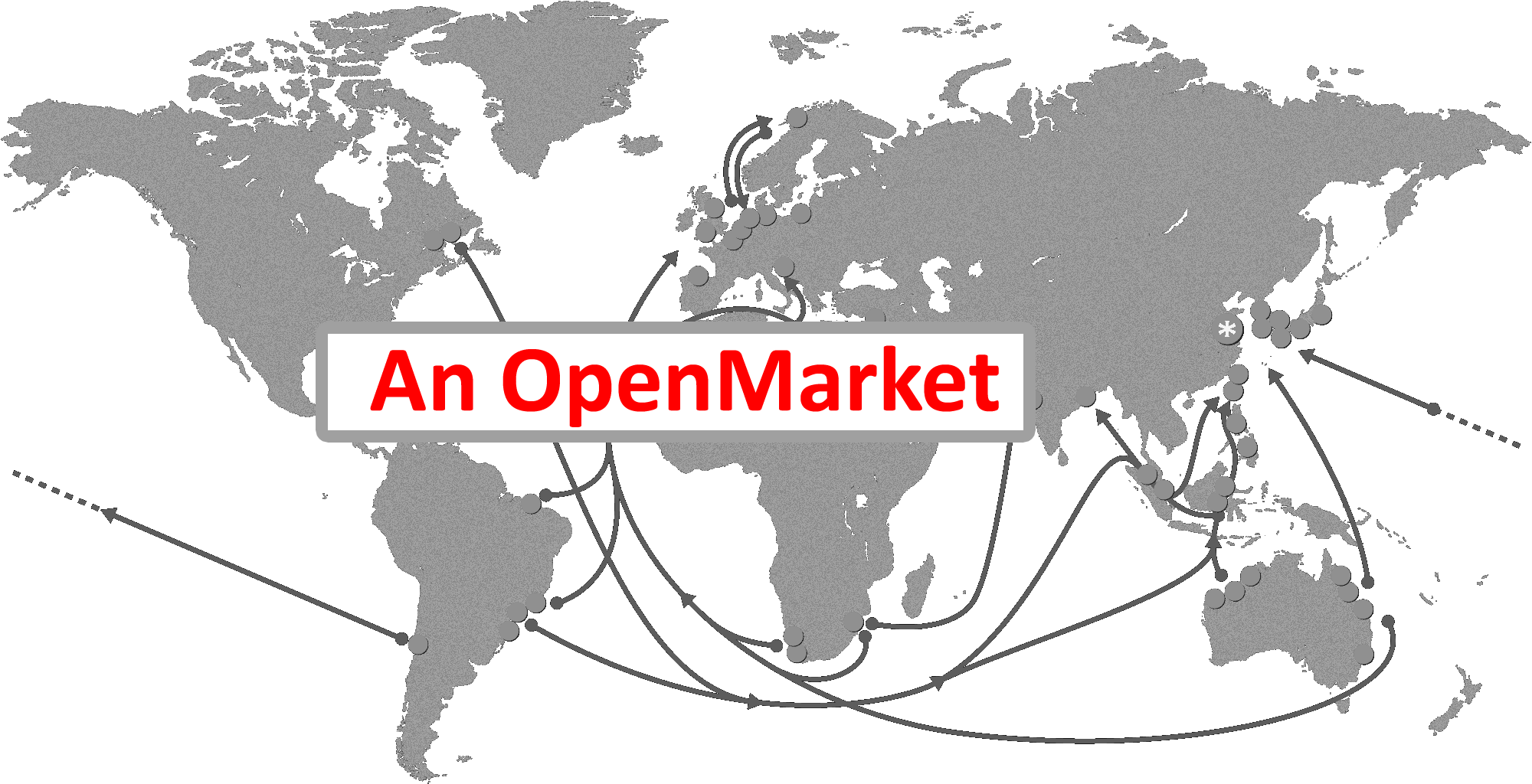Open Market: Unlocking the Potential of Free Trade | Business Blogs By Busivold
An open market is a cornerstone of modern economies, fostering growth, innovation, and consumer empowerment. It represents a system where goods, services, and financial instruments are traded freely, with minimal restrictions or government intervention. In an open market, the forces of supply and demand play a crucial role in determining prices and availability of products, leading to a dynamic economic environment. This blog explores the concept of open markets, their characteristics, significance, and their transformative impact on economies worldwide. Understanding these principles can help both consumers and businesses navigate the complexities of today’s global trade landscape.

What is an Open Market?
An open market is characterized by:
- Minimal Barriers: There are no significant restrictions on entry or exit for participants.
- Competition-Driven Prices: Supply and demand dictate prices rather than centralized controls.
- Global Accessibility: Participants from any geographical location can engage without discrimination.
- Transparency: Information about products, services, and prices is readily available to all participants.
Why Are Open Markets Important?
1. Encourages Economic Efficiency
Open markets promote competition, which compels businesses to optimize their operations, reduce costs, and enhance productivity. This results in better resource allocation and improved economic performance.
2. Benefits Consumers
Consumers enjoy a broader range of choices at competitive prices. This competitive landscape ensures that quality improves while costs decline, providing better value.
3. Fosters Innovation
Economic efficiency driven by this type of markets can be illustrated through the concept of comparative advantage. When countries specialize in producing goods they can make most efficiently, it leads to increased overall production. For instance, if Country A can produce wine more efficiently than Country B, while Country B excels in cheese production, both nations benefit from trading these products. This specialization and trade allow for greater variety and lower prices for consumers, demonstrating the power in promoting efficiency.
The need to stay ahead in a competitive market drives businesses to innovate. They are incubators for technological advancements and creative solutions.
4. Attracts Investments
The benefits to consumers in open markets extend beyond mere choice. For instance, the competition among brands encourages continuous improvement in product quality and customer service. A notable example can be seen in the smartphone industry, where companies like Apple, Samsung, and Google constantly innovate and enhance their products. As a result, consumers enjoy cutting-edge technology at competitive prices, which would not be possible in a monopolized market.
Investors are drawn to these markets due to their predictability and potential for high returns. Transparent systems inspire confidence and boost economic activity.
Innovation often comes from the need to address consumer demands. For example, the rise of health and fitness consciousness has led to a boom in wearable technology. Companies that adapt to this trend, like Fitbit and Apple with their health-monitoring features, showcase how businesses can thrive by meeting evolving consumer preferences. This responsiveness is a hallmark of open markets, where the consumer’s voice drives innovation.
5. Drives Economic Growth
Growth driven by open markets also has societal implications. As economies expand and businesses flourish, job creation tends to follow. For instance, the tech boom in Silicon Valley has resulted in thousands of new jobs, from engineering to marketing. This growth not only benefits individuals but also contributes to the overall economic health of the region and the country, highlighting the interconnectedness of open markets and employment opportunities.
By promoting innovation, investment, and efficient practices, open markets contribute significantly to the overall growth and stability of economies.
They can also lead to cultural exchanges and increased understanding among nations. As businesses operate in multiple countries, they bring diverse perspectives and practices that enrich local cultures. For example, the presence of international fast-food chains has introduced new dining experiences while also prompting local businesses to elevate their service offerings to compete. This cultural crossover shows that open markets are not just about economics; they also foster global interactions that can enhance social cohesion.
They are not just theoretical constructs; they are evident in our daily interactions and transactions. For example, consider how online platforms have changed the way we shop. In the past, consumers were limited to local stores with fixed prices and limited options. Today, with the advent of e-commerce, buyers can access products from around the world, compare prices instantly, and make informed choices. This shift has not only increased consumer satisfaction but has also forced traditional retailers to adapt by improving their offerings and customer service.
Real-World Examples of different Open Markets
1. Stock Markets
Platforms like the New York Stock Exchange (NYSE) and Bombay Stock Exchange (BSE) epitomize open markets, enabling transparent trading of securities.
2. E-Commerce Platforms
Companies like Amazon and Flipkart operate as open markets, connecting buyers and sellers worldwide with minimal restrictions.
3. Global Trade Networks
International organizations like the World Trade Organization (WTO) advocate for open markets by reducing trade barriers among member countries.
However, the potential drawbacks of open markets are significant and warrant attention. Market failures such as monopolies can stifle competition and innovation. It is important for governments to monitor these situations closely and implement regulations that ensure a level playing field for all participants. For instance, antitrust laws play a vital role in preventing large corporations from abusing their market power, ensuring that smaller businesses have a chance to thrive.
Challenges :
While open markets offer numerous benefits, they are not without challenges :
Economic inequality is another challenge associated with open markets. When certain sectors or demographics dominate market participation, it can lead to disparities in wealth and opportunity. To address this issue, policies that promote inclusivity and support underrepresented groups are necessary. For example, initiatives like microfinance programs can empower small entrepreneurs and stimulate economic participation among marginalized communities.
Environmental and social costs are critical considerations in open markets. The pursuit of profit can sometimes lead to practices that harm communities or degrade the environment. Corporate social responsibility (CSR) efforts are becoming increasingly important, as businesses recognize the need to operate sustainably. For instance, companies that prioritize ethical sourcing and minimize their carbon footprint not only contribute to the planet’s well-being but also enhance their brand reputation among consumers who prefer eco-friendly practices.
- Market Failures: Monopolies or oligopolies may arise, limiting competition.
- Economic Inequality: Disparities in resources can lead to unequal participation and outcomes.
- Environmental and Social Costs: Unchecked activities may result in exploitation or negative externalities like pollution.
- Vulnerability to Shocks: Open markets are susceptible to global economic fluctuations and crises.
Finally, the vulnerability of open markets to global economic shocks is a significant concern. Events like financial crises or pandemics can disrupt trade and economic stability. Diversification of supply chains and building resilience through strategic planning are essential for businesses to withstand these shocks. For example, companies that adapt quickly to changing market conditions—like those that pivoted to e-commerce during the COVID-19 pandemic—demonstrate the importance of agility in an open market environment.
India’s evolution as an open market is multifaceted and continues to unfold. The e-commerce revolution has not only transformed how Indians shop but has also encouraged local businesses to adopt digital strategies to reach wider audiences. This digital shift is vital for small and medium enterprises (SMEs) that can leverage technology to compete on a global scale. Moreover, India’s liberalized trade policies have attracted foreign direct investment, fostering economic ties that enhance development and innovation across various sectors.
Open Markets in India
India’s journey toward becoming an open market began with the 1991 economic liberalization reforms. Key examples of open market principles in India include:
- E-Commerce Revolution: Platforms like Amazon India and Flipkart have transformed retail by connecting millions of sellers and buyers.
- Liberalized Trade Policies: Reduced tariffs and trade barriers have boosted exports and foreign investment.
- Stock Exchanges: The National Stock Exchange (NSE) and BSE exemplify open financial markets fostering economic growth.
The stock exchanges in India serve as a barometer for economic health, demonstrating the correlation between open markets and investor confidence. As more companies list on these exchanges, it reflects not only the growth of the economy but also the increasing faith of investors in India’s market potential. This trend is crucial for maintaining momentum in economic development and ensuring that the benefits of open markets are felt broadly across society.
Conclusion
Open markets are essential for fostering economic dynamism, innovation, and global cooperation. They create an environment where free competition empowers businesses and consumers alike, leading to better products and services. However, for these markets to function optimally, effective regulation is necessary to mitigate potential drawbacks such as market failures and inequality. By embracing the principles of open markets and addressing their challenges, we can unlock immense potential for sustainable growth and prosperity, paving the way for a more equitable and prosperous future.








